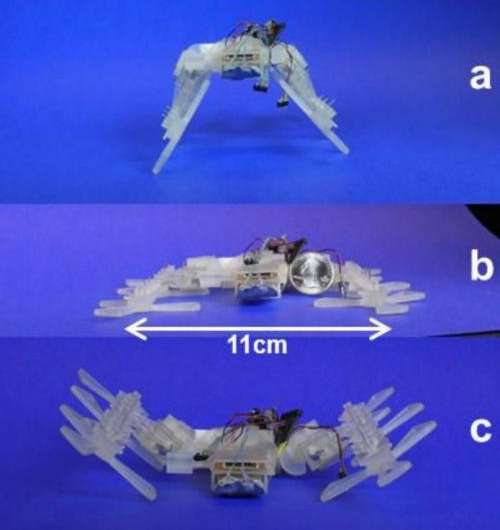August 3, 2013 report
3D printer-built robot has insect moves (w/ Video)

(Phys.org) —Some robotics experts focused on biomimicry have turned to work in tech hives where their tiny robots are designed to imitate the moves of insects. At UC Berkleley's Biomimetic Millisystems Lab, David Zarrouk, Andrew Pullin, Nick Kohut, and Ronald Fearing are working on STAR, which stands for Sprawl Tuned Autonomous Robot. In their paper of the same title, "STAR, A Sprawl Tuned Autonomous Robot," they present their project, a six-legged, sprawl-tuned robot with a variable leg sprawl angle in the transverse plane to adapt its stiffness, height, and leg-to-surface contact angle.
They wrote that the sprawl angle can be varied from nearly positive 60 degrees to negative 90 degrees, with the robot running in a planar configuration, upright, or inverted. Translation: The little robots can move like insects and make themselves flat while squeezing under doors, then raising themselves upright, ready to scale obstacles and scurry across the floor at a rapid speed.
The velocity increases over smooth surfaces, with stable running at all velocities up to 5.2 m/s. Depending on the angle, the robot can move over different surfaces and slip into narrow passageways.
This is a 3D-printed robot that weighs just 73 g including battery and control board. The length of the robot is 12 cm. The team said that STAR's wheel-like legs provide high electromechanical conversion efficiency and enable the robot to achieve legged performance over rough surfaces and obstacles. The STAR was designed for easy assembly and simple part replacement. "STAR is designed for rapid manufacturing," the authors wrote in their paper.
They used a ProJet 3000 3D printer for the STAR components: body core, motor housing, spur gears, and legs. The printer accuracy is about 0.05mm.
The robot is designed for easy assembly and simple part replacement, and the total mechanical assembly requires roughly 30 minutes. The main core of the robot holds its control board and battery, which are connected to the six legs that propel it forward. They used a 300mA-hr LiPo, 4V battery, which offers 30 minutes' endurance when running at full drive capacity.
The reconfigurable sprawl angle of STAR gives this miniature robot unique capabilities and performance when having to move up, down, under, and across varying surfaces and obstacles.
STAR is just one of several projects from the school's Biomimetic Millisystems Lab. The lab attempts to harness features of animal manipulation, locomotion, sensing, actuation, mechanics, dynamics, and control strategies. The lab works closely with biologists to develop models whose functions can be tested on systems.
The authors suggested that the value of STAR could be realized in rescue and search scenarios:
"Drawing inspiration from insects, miniature crawling robots possess substantial advantages over wheeled vehicles for off-road locomotion, such as in caves and collapsed buildings, for reconnaissance and search and rescue purposes."
More information:
robotics.eecs.berkeley.edu/~ronf/Biomimetics.html
STAR, A Sprawl Tuned Autonomous Robot, robotics.eecs.berkeley.edu/~ro … uk-sprawl-icra13.pdf
© 2013 Phys.org




















